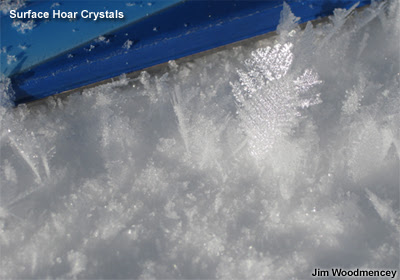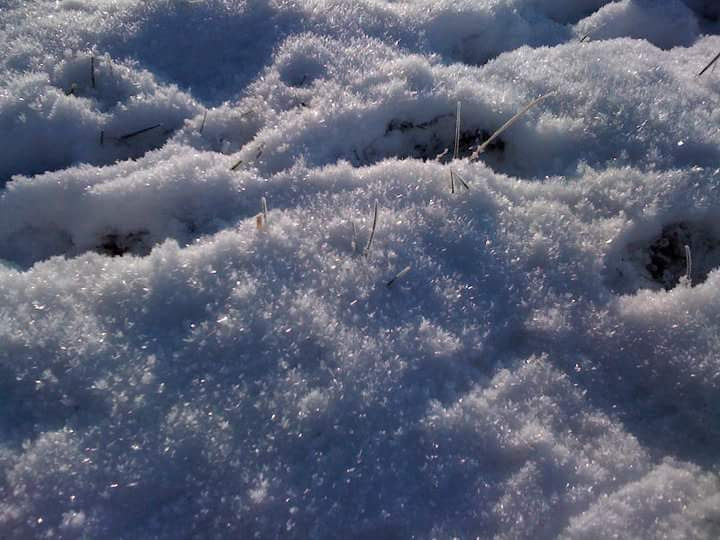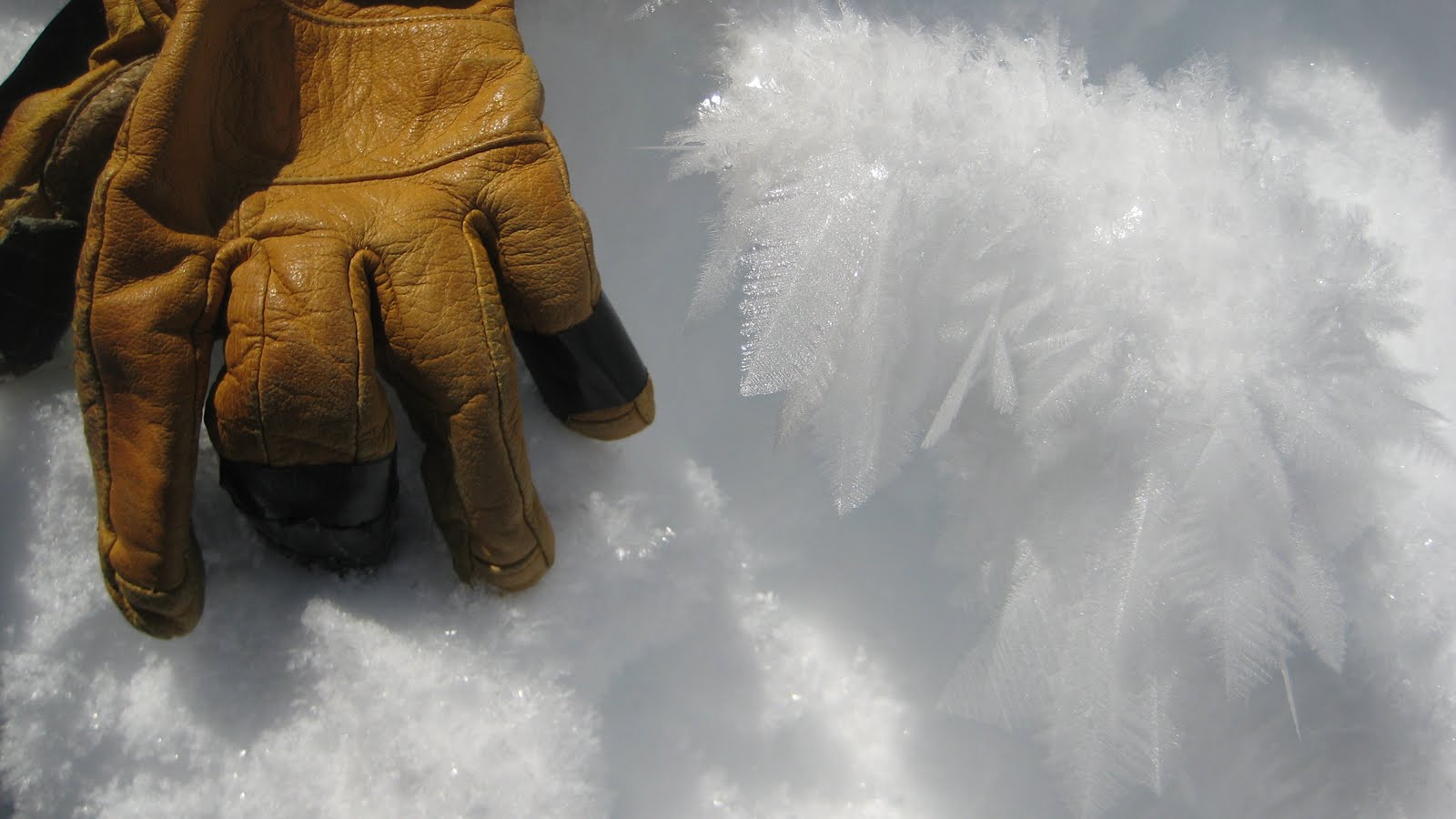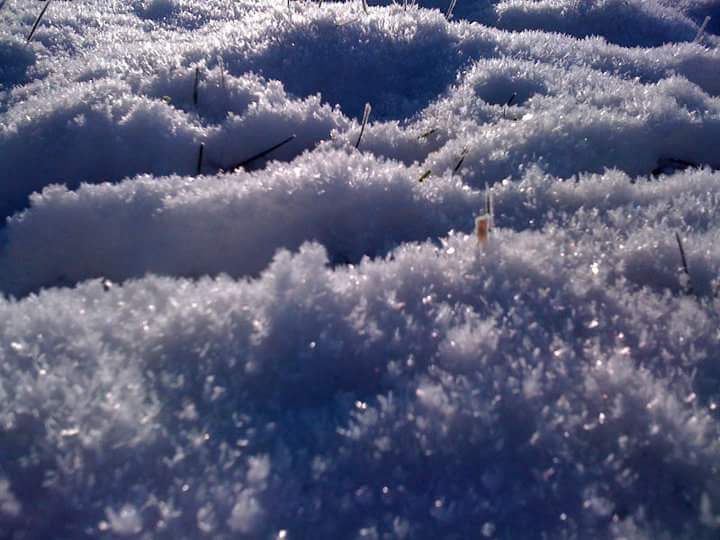ATSC 113 Weather for Sailing, Flying & Snow Sports
Surface Hoar
Learning Goal 7i. Describe the atmospheric conditions for surface hoar formation and how this might lead to an avalanche

Fig. 7i.1 Surface hoar crystals glistening in the sun. (Credit: COMET/UCAR.)
Here are some definitions and reminders that will help you with this section:
- Deposition occurs when a substance undergoes a phase change directly from the gas to the solid phase, without the liquid stage in between. For instance, the deposition of water is when it changes from water vapour (gas) into ice (solid) without passing through the liquid water phase. It literally deposits itself onto the snow surface.
- Dewpoint temperature is the air temperature at which water vapour starts to condense into liquid droplets, while being cooled. This concept was introduced in Flying Module 1h.
- Frostpoint temperature is the dewpoint
temperature if the air is below 0°C. Instead of dew, frost forms.
What is surface hoar?
Surface hoar or hoarfrost or just frost is essentially the frozen version of dew. It is produced by deposition onto the snow surface when the air temperature falls below the frostpoint temperature. The outcome is the formation of ice crystals on the top of the snow surface.

Fig. 7i.2 - Surface hoar. (Credit: Howard.)
What is needed for surface hoar to form?
- Clear skies, usually at night, causing the snow surface temperature to decrease greatly due to radiative cooling.
- Calm or near-calm winds, less than 15 km/h. A small amount of wind is necessary to deliver new water vapour supplies as the water vapour deposits onto the surface as ice. This small amount of wind can be provided by subtle downslope flows (Learning Goal 6b).
- A strong temperature inversion (Learning Goal 6c) just above the snow surface, usually a result of clear skies and calm winds. This means that the air just above the snow surface is relatively warm, around 10°C warmer or more, compared to the snow (even though the air is often still quite cold).
- The size of the hoarfrost depends on how long the weather conditions remain this way, although it can form in just a few minutes. If it forms for a prolonged period, it can reach several centimetres in size (Fig. 7i.3).
- Hoarfrost can keep forming into the daytime on north-facing slopes that are in the shade, because they continue to cool radiatively with little or no heating from the sun. On these shady slopes, it may not melt during the day. If there is a high pressure system, it can continue to grow night after day after night.
- Surface hoar forms best on a flat, open surface. If there are trees or rocks very close by this may inhibit formation due to radiative warming from these "objects". This warming prevents the snow surface from cooling down as much as it would otherwise. For this reason, surface hoar coverage can vary greatly between forested areas and treeless areas, such as clear cuts or slide paths (paths that have been cleared by previous avalanches or landslides).

Fig. 7i.3 Surface hoar that has formed over a long period, perhaps all night and into the next morning. (Credit: West.)
What hazards does surface hoar present?
Surface hoar can lead to avalanches. As you can see from the photographs (Figs. 7i.1-7i.4), surface hoar is very feathery and delicate. When it's on the snow suface, it presents no danger. Once it's buried by subsequent snowfall, however, the surface hoar acts as a weak layer within the snowpack. With a layer of snow on top, the hoarfrost layer is prone to collapsing easily, since there are very few bonds between ice crystals and lots of empty air space, compared with the rest of the snowpack. This can cause an avalanche.
If the surface hoar is uniform over a large area, as may happen in alpine areas after a long period of high pressure, the weakness may be widepread. With these conditions, larger slab avalanches are more likely (Learning Goal 7j). This is where a large area of the slope fails and slides downhill.
Further, this weak layer can sometimes remain buried for weeks. This would be called a persistent weak layer . The gradual accumulation of snow on top (which may be a metre or more over a few weeks) may or may not be enough to trigger an avalanche. However, if it gets just the right trigger, such as a heavy snowmobile, the weak layer can fail, potentially leading to a large, destructive avalanche.
Backcountry users, avalanche forecasters, and ski patrollers dig snowpits to assess the different layers in the snowpack. This is one way to determine whether a layer of buried surface hoar is present.
What destroys surface hoar?
- Sunlight or warm air causing sublimation (phase change from ice directly to vapour).
- Strong winds, either by sublimation again, or mechanically, if the wind is so strong it blows the light feathery crystals away.
- Melting/refreezing e.g. during the daytime.
- Rain or freezing rain.
After a long period of high pressure where there has been significant surface hoar formation, backcountry users hope the first storm that comes in starts off warm. In these cases, warm winds ahead of the storm may largely eliminate the surface hoar (and its associated danger). Also with a warm storm, the precipitation may start as rain, which would also eliminate the surface hoar.

Fig. 7i.5 Surface hoar glistening in the sun. (Credit: Howard.)
Key words: deposition, dewpoint, frostpoint, surface hoar, hoarfrost, frost, slab avalanches, persistent weak layer
Figure Credits: Howard: Rosie Howard, West: Greg West, Stull: Roland Stull